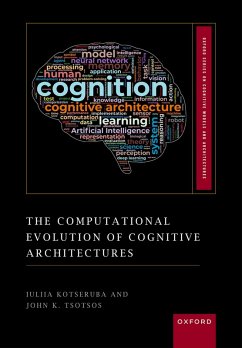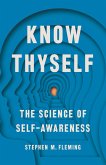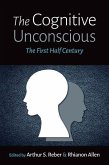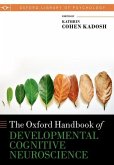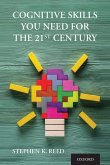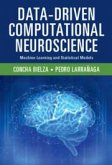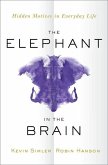- Gebundenes Buch
- Merkliste
- Auf die Merkliste
- Bewerten Bewerten
- Teilen
- Produkt teilen
- Produkterinnerung
- Produkterinnerung
In this volume, the authors trace the evolution of cognitive architectures, their abilities, and future prospects, from their early logic-based beginnings to their recent melding of classic methodologies with deep learning concepts.
Andere Kunden interessierten sich auch für
![Emotions in Humans and Artifacts Emotions in Humans and Artifacts]() Robert Trappl / Paolo Petta / Sabine Payr (eds.)Emotions in Humans and Artifacts12,99 €
Robert Trappl / Paolo Petta / Sabine Payr (eds.)Emotions in Humans and Artifacts12,99 €![Know Thyself Know Thyself]() Stephen M FlemingKnow Thyself22,99 €
Stephen M FlemingKnow Thyself22,99 €![The Cognitive Unconscious The Cognitive Unconscious]() Arthur S ReberThe Cognitive Unconscious90,99 €
Arthur S ReberThe Cognitive Unconscious90,99 €![The Oxford Handbook of Developmental Cognitive Neuroscience The Oxford Handbook of Developmental Cognitive Neuroscience]() The Oxford Handbook of Developmental Cognitive Neuroscience219,99 €
The Oxford Handbook of Developmental Cognitive Neuroscience219,99 €![Cognitive Skills You Need for the 21st Century Cognitive Skills You Need for the 21st Century]() Stephen K ReedCognitive Skills You Need for the 21st Century46,99 €
Stephen K ReedCognitive Skills You Need for the 21st Century46,99 €![Data-Driven Computational Neuroscience Data-Driven Computational Neuroscience]() Concha BielzaData-Driven Computational Neuroscience95,99 €
Concha BielzaData-Driven Computational Neuroscience95,99 €![The Elephant in the Brain The Elephant in the Brain]() Kevin SimlerThe Elephant in the Brain48,99 €
Kevin SimlerThe Elephant in the Brain48,99 €-
-
-
In this volume, the authors trace the evolution of cognitive architectures, their abilities, and future prospects, from their early logic-based beginnings to their recent melding of classic methodologies with deep learning concepts.
Produktdetails
- Produktdetails
- Verlag: Oxford University Press
- Seitenzahl: 304
- Erscheinungstermin: 30. September 2025
- Englisch
- Abmessung: 251mm x 179mm x 26mm
- Gewicht: 689g
- ISBN-13: 9780192844835
- ISBN-10: 0192844830
- Artikelnr.: 73849860
- Herstellerkennzeichnung
- Libri GmbH
- Europaallee 1
- 36244 Bad Hersfeld
- gpsr@libri.de
- Verlag: Oxford University Press
- Seitenzahl: 304
- Erscheinungstermin: 30. September 2025
- Englisch
- Abmessung: 251mm x 179mm x 26mm
- Gewicht: 689g
- ISBN-13: 9780192844835
- ISBN-10: 0192844830
- Artikelnr.: 73849860
- Herstellerkennzeichnung
- Libri GmbH
- Europaallee 1
- 36244 Bad Hersfeld
- gpsr@libri.de
Iuliia Kotseruba is a Postdoctoral Visitor at York University, Canada, where she received her PhD and MSc in Computer Science focusing on cognitive systems and transportation safety. Prior to that she obtained her BSc in AI from University of Toronto and BA in Philosophy from National University of Kyiv-Mohyla Academy. She works on intelligent systems inspired by human vision, attention, and cognition. She has spent the past decade building and surveying cognitive architectures and has been a keynote speaker and a contributor to major AI conferences. She has authored over thirty scientific papers on various topics from visual saliency to intelligent transportation. John Tsotsos is Distinguished Research Professor of Vision Science, York University, Canada. He received his PhD in Computer Science from the University of Toronto in 1980, joined their faculty, and founded the University of Toronto's Computer Vision Group, leading it for 20 years. He moved to York University in 2000 as Director, Centre for Vision Research. His honours include CIFAR Fellow, Canada Research Chair in Computational Vision, IEEE Life Fellow, Fellow Canadian Academy of Engineering, and Fellow of the Royal Society of Canada. He received the 2015 Sir John William Dawson Medal for sustained excellence in multidisciplinary research and the 2020 CS-Can
Foreword
What is this book about?
I. COGNITIVE ARCHITECTURES: AN OVERVIEW
1: What are Cognitive Architectures?
2: Cognitive Architectures, AI, and Cognitive Science
3: Taxonomies of Cognitive Architectures
II. HOW ARE COGNITIVE ARCHITECTURES BUILT?
4: Sensation and Perception
5: Memory
6: Learning
7: Reasoning and Decision-Making
8: Putting It All Together
III. WHAT CAN COGNITIVE ARCHITECTURES DO?
9: Practical Applications of Cognitive Architectures
10: Evaluating Cognitive Architectures
IV. WHAT IS NEXT?
11: Cognitive Architectures in the Deep Learning Era
12: Challenges of the Past and Opportunities Ahead
References
What is this book about?
I. COGNITIVE ARCHITECTURES: AN OVERVIEW
1: What are Cognitive Architectures?
2: Cognitive Architectures, AI, and Cognitive Science
3: Taxonomies of Cognitive Architectures
II. HOW ARE COGNITIVE ARCHITECTURES BUILT?
4: Sensation and Perception
5: Memory
6: Learning
7: Reasoning and Decision-Making
8: Putting It All Together
III. WHAT CAN COGNITIVE ARCHITECTURES DO?
9: Practical Applications of Cognitive Architectures
10: Evaluating Cognitive Architectures
IV. WHAT IS NEXT?
11: Cognitive Architectures in the Deep Learning Era
12: Challenges of the Past and Opportunities Ahead
References
Foreword
What is this book about?
I. COGNITIVE ARCHITECTURES: AN OVERVIEW
1: What are Cognitive Architectures?
2: Cognitive Architectures, AI, and Cognitive Science
3: Taxonomies of Cognitive Architectures
II. HOW ARE COGNITIVE ARCHITECTURES BUILT?
4: Sensation and Perception
5: Memory
6: Learning
7: Reasoning and Decision-Making
8: Putting It All Together
III. WHAT CAN COGNITIVE ARCHITECTURES DO?
9: Practical Applications of Cognitive Architectures
10: Evaluating Cognitive Architectures
IV. WHAT IS NEXT?
11: Cognitive Architectures in the Deep Learning Era
12: Challenges of the Past and Opportunities Ahead
References
What is this book about?
I. COGNITIVE ARCHITECTURES: AN OVERVIEW
1: What are Cognitive Architectures?
2: Cognitive Architectures, AI, and Cognitive Science
3: Taxonomies of Cognitive Architectures
II. HOW ARE COGNITIVE ARCHITECTURES BUILT?
4: Sensation and Perception
5: Memory
6: Learning
7: Reasoning and Decision-Making
8: Putting It All Together
III. WHAT CAN COGNITIVE ARCHITECTURES DO?
9: Practical Applications of Cognitive Architectures
10: Evaluating Cognitive Architectures
IV. WHAT IS NEXT?
11: Cognitive Architectures in the Deep Learning Era
12: Challenges of the Past and Opportunities Ahead
References

